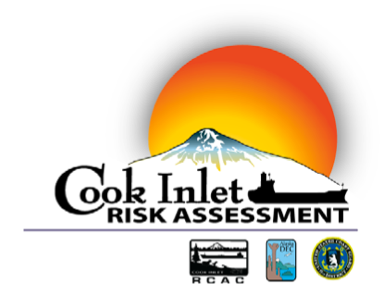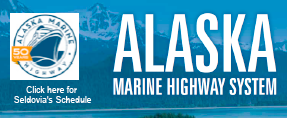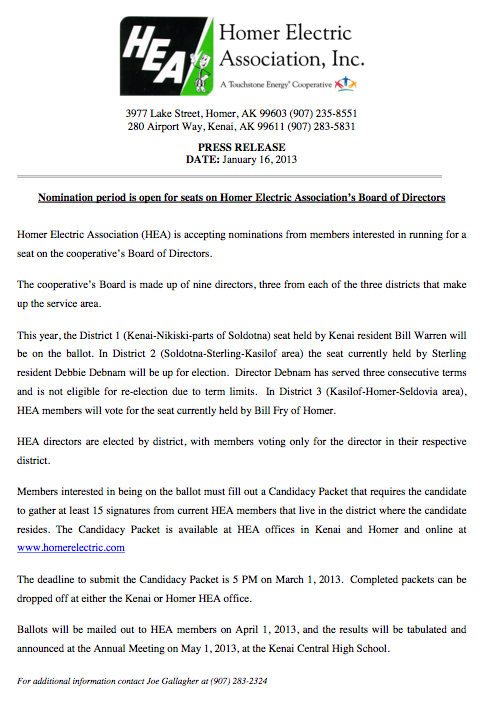Tag: Seldovia
SVT Health & Wellness Taking Back Unwanted Prescription Drugs
NEWS RELEASE
For Immediate Release
January 10, 2013
 SVT HEALTH & WELLNESS TAKING BACK UNWANTED PRESCRIPTION DRUGS JANUARY 25TH
SVT HEALTH & WELLNESS TAKING BACK UNWANTED PRESCRIPTION DRUGS JANUARY 25TH
HOMER, ALASKA – On Friday, January 25th from 9 a.m. to 5 p.m., SVT Health & Wellness and the Drug Enforcement Administration (DEA) will give the public another opportunity to prevent pill abuse and theft by ridding their homes of potentially dangerous expired, unused and unwanted prescription drugs. Bring your medications for disposal to SVT Health & Wellness Homer Health Center at 880 East End Road, or to the SVT Health & Wellness Clinic in Seldovia at 206 Main Street. The service is free and anonymous, no questions asked.
Last April, Americans turned in 552,161 pounds—276 tons—of prescription drugs at more than 5,600 sites operated by the DEA and nearly 4,300 state and local law enforcement partners. In its four previous Take Back events, DEA and its partners took in more than 1.5 million pounds—nearly 775 tons—of pills.
“This initiative addresses a vital public safety and public health issue,” SVT Health & Wellness’ Public Relations Director Ian McGaughey said. “Medicines that languish in home cabinets are highly susceptible to diversion, misuse and abuse.”
Rates of prescription drug abuse in the U.S. are alarmingly high, as are the number of accidental poisonings and overdoses due to these drugs. Studies show that a majority of abused prescription drugs are obtained from family and friends, including from the home medicine cabinet. In addition, Americans are now advised that their usual methods for disposing of unused medicines—flushing them down the toilet or throwing them in the trash—both pose potential safety and health hazards.
Four days after the first event, Congress passed the Secure and Responsible Drug Disposal Act of 2010, which amends the Controlled Substances Act to allow an “ultimate user” of controlled substance medications to dispose of them by delivering them to entities authorized by the Attorney General to accept them. The Act also allows the Attorney General to authorize long term care facilities to dispose of their residents’ controlled substances in certain instances. DEA is drafting regulations to implement the Act. Until new regulations are in place, local law enforcement agencies like SVT Health & Wellness and the DEA will continue to hold prescription drug take-back events every few months.
For more information, please contact Ian McGaughey, Public Relations and Marketing Director at 435-3266 or imcgaughey@svt.org.
Cook Inlet Risk Assessment Seeks Ideas to Lower Risks of Maritime Accidents
 For immediate release
For immediate release
January 16, 2013
Contact: Tim Robertson, 907.234.7821
Cook Inlet Risk Assessment seeks ideas to lower risks of maritime accidents
The Cook Inlet Risk Assessment Advisory Team is considering risk reduction measures for Cook Inlet and opening the door for the public to weigh in with their ideas. The U. S. Coast Guard, Cook Inlet Regional Citizens Advisory Council, and the Alaska Department of Environmental Conservation created the Cook Inlet Risk Assessment to analyze the risks associated with marine vessel operations in the inlet and recommend measures to reduce the chances of accidents and resulting oil spills.
A risk reduction measure can be any policy, procedure, rule, equipment, system, or service that would lower the chance of a marine incident or reduce the impact of an incident if it should occur. It can be something fairly obvious or traditional such as a Vessel Traffic System that monitors and controls the movement of vessels transiting Cook Inlet. Or, it may be something less obvious, such as a sub-sea pipeline that would take the place of tankers moving oil across Cook Inlet.
The Advisory Panel will consider all suggestions for further study. A list of some risk reduction measures already slated for consideration is posted on the project website at www.cookinletriskassessment.com. People are invited to submit ideas and/or share their thoughts about the options that have already been suggested.
Ideas for risk reduction measures can be submitted by email to ciracomments@nukaresearch.com, by mail to CIRA Comments, Nuka Research, PO Box 175, Seldovia, AK 99663, or by fax to (240) 394-4855. The deadline for comments is February 4, 2013. The Advisory Panel will meet in late February to consider all suggestions.
The Cook Inlet Risk Assessment project is guided by a Management Team, comprised of the agencies noted above, and an Advisory Panel of 14 stakeholders including mariners, marine pilots, port directors, fishermen, subsistence users, and other experts. Thus far, they have completed three technical studies analyzing the vessel traffic, accident frequencies, and potential consequences from spills.
-END-
Background: The Cook Inlet Regional Citizens Advisory Council (Cook RCAC), Alaska Department of Environment Conservation and U.S. Coast Guard launched the Cook Inlet Risk Assessment to examine the risk of oil spills posed by the marine vessels transiting through, near and/or servicing the region. The goal of the risk assessment is to answer the following questions:
• What can go wrong?
• How likely is it?
• What are the impacts?
• Can the impacts be mitigated?
The risk assessment is examining the current types and sizes of vessels plying Cook Inlet and dominant accident types and identifying future oil spill risks based on vessel size, type and frequency. The first phase of the risk assessment was limited to a semi-qualitative analysis, relying primarily on historical data, expert opinion, and lessons learned from prior studies. Study results provided a basis for the identification and initial ranking of risk reduction measures.
We have sought extensive stakeholder engagement throughout the process of defining and analyzing risks and identifying risk reduction measures.
Initial funding for the risk assessment was secured through a legislative appropriation by State of Alaska and is being administered by the Kenai Peninsula Borough and Cook Inlet RCAC.
More information can be obtained at www.cookinletriskassessment.com
For more information: Lynda Giguere, 907.398.6205 or Giguere@circac.org











 Seldovia Time
Seldovia Time









